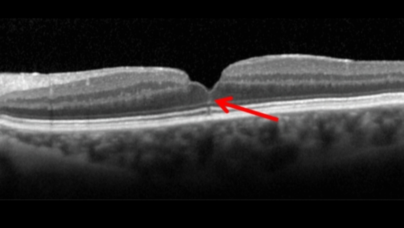
Fissure fovéolaire
OCT: Anticiper le risque de trou maculaire
"Docteur, est-ce que je risque de faire un trou maculaire de l'autre œil ?"
Signe de fissure fovéolaireUn petit signe qu’on a tous vu à l’OCT : une fine ligne verticale hyper-réflective au niveau de la fovéa. Image SD-OCT de la fovéa issue de l’article : coupe horizontale : fissure fovéolaire définie comme une fine ligne hyper-réflective verticale allant de la ligne de l’ellipsoïde à la rétine interne. Notons la présence d’une petite membrane épirétinienne, et une absence de décollement postérieur du vitré.
Ce signe, qui m’a été remis en mémoire grâce à la bibliographie de deux articles parus en 2023, est un facteur de risque de trou maculaire. Rates of Fellow Eye Macular Hole Development During Long Term Follow-Up. Post-vitrectomy secondary macular holes: Risk factors, clinical features, and multivariate analysis of outcome predictors.
L’article cité est un article publié en 2020 dans un journal du groupe Nature :Foveal crack sign as a predictive biomarker for development of macular hole in fellow eyes of patients with full-thickness macular holes
Ce signe a une valeur prédictive de 52,6 % pour détecter de futurs cas de trou maculaire et de 97,9 % pour les exclure si le résultat est négatif. L’étude présentée dans ce papier porte sur 113 yeux ayant fait un trou maculaire et 113 yeux témoins Si on ajoute à la présence de cette « fissure fovéolaire » l’absence de décollement postérieur du vitré, le risque de trou maculaire passe à 76,9%.
Ainsi, vous pourrez répondre à la question classiquement posée par les patients ayant fait un trou maculaire : « quel est le risque que cela m’arrive de l’autre côté ? » 1- Regardez s’il y a un décollement postérieur du vitré 2- Regardez s’il y a une fissure fovéolaire
Voici l’image tirée de l’article d’Olga Furashova Figure 1 SD-OCT of the fovea (horizontal line scan) with the foveal crack sign preceding macular hole formation in a 76-year-old-man. (a) Foveal crack sign in the umbo of the left eye with mild vitreomacular traction. (b) Progression to full-thickness macular hole formation 9 months later.
Abstract To investigate the prevalence and predictive value of the foveal crack sign (FCS) in fellow eyes of patients with full-thickness macular holes (FTMH) regarding future macular hole (MH) formation. In a retrospective observational case series, 113 fellow eyes of 113 patients with FTMH have been observed during a mean follow-up time of 21 months. According to baseline SD-OCT images, patients were divided into 4 separate groups: patients with FCS and vitreous adhesion, patients with FCS and vitreous detachment, patients without FCS with vitreous adhesion, patients without FCS with vitreous detachment. Progression rate to MH formation, predictive value of FCS and of vitreous interface status were calculated and compared across the four groups. FCS was observed in 19 of 113 fellow eyes (17%) of patients with FTMH, 10 of them with progression to MH during the mean follow up time of 21 months. 2 other eyes with progression to MH showed no FCS at baseline. Progression rate was shown to be 77% (10 of 13 eyes) in patients with FCS and vitreous adhesion, 0% (none of 6 eyes) in patients with FCS and vitreous detachment, 4% (2 of 48 eyes) in patients without FCS with vitreous adhesion, 0% (none of 46 eyes) in patients without FCS with vitreous detachment. FCS had sensitivity of 83.3% (95% CI 50.9-97.1%) and specificity of 91.1% (95% CI 83.3-95.6%) in predicting MH formation, positive predictive value of FCS was 52.6% (95% CI 29.5-74.8%) and negative predictive value 97.9% (95% CI 91.8-99.6%). Having simultaneously FCS and vitreous adhesion showed 83.3% (95% CI 50.9-97.1%) sensitivity and 97.1% (95% CI 91.1-99.2%) specificity in predicting macular hole formation; positive predictive value was 76.9% (95% CI 46.0-93.8%) and negative predictive value was 98.0% (95% CI 92.4-99.7%). Fellow eyes of patients with FTMH with foveal crack sign are at a very high risk (77%) of FTMH development, as long as posterior vitreous adhesion is present.
|


